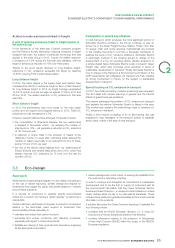APC 2012 Annual Report Download - page 74
Download and view the complete annual report
Please find page 74 of the 2012 APC annual report below. You can navigate through the pages in the report by either clicking on the pages listed below, or by using the keyword search tool below to find specific information within the annual report.
2012 REGISTRATION DOCUMENT SCHNEIDER ELECTRIC72
SUSTAINABLE DEVELOPMENT
2COMMITTED TO AND ON BEHALF OFEMPLOYEES
•selection and implementation of a new data collection and
management system for the collection and analysis of workplace
occupational health, safety&environmental metrics and events.
The system has been selected (named “GlobES”) and the metrics
and events modules are scheduled to debut in2013.
Objectives
Schneider Electric is using three primary indicators to measure
their occupational health&safety performance. The fi rst of these
indicators is the Medical Incident Rate (MIR) which measures the
number of medical cases per million of hours worked. This measure
allows for a deep evaluation of workplace hazards, and the resulting
corrective actions assist in the elimination of recurring incidents and
the prevention of injury. Schneider Electric has used the MIR as
a key performance indicator on a global basis since2010 with a
target to reduce the MIR by 10% year over year.
The second and third indicators are the Lost-time Incident Rate
(LTIR) and the Lost-time Day Rate (LTDR) respectively. These two
indicators are globally standardized versions of the Frequency Rate
(FR) and Seriousness Rate (SR) used in the past. By standardizing
on the two terms it allows for consistent defi nitions that can be
implemented on a global basis. The LTIR measures the number
of medical cases that incur lost-time work days per million hours
worked. These lost-time cases are indicators of a more serious type
of medical case. The seriousness of these cases is indicated by the
LTDR which measures the number of days lost due to the lost-time
medical cases per million hours worked. Both the LTIR and LTDR
are presented this year in place of the FR and SR. Both indicators
also have a target reduction of 10% year over year.
The FR and SR reported in2011 have been reworked to the current
LTIR and LTDR defi nitions for use in comparing the results for2012.
Beginning of2013, a downward restatement of the MIR has been
done, taking into account errors that have been revealed thanks
to the audit work of extra-fi nancial data 2012. The MIR 2011 is
not 4.77 as stated in the Registration Document 2011, but 4.49 .
Therefore the 2012 results for MIR, LTIR and LTDR are as follows:
•MIR 2011 = 4.49 ; MIR 2012 = 3.44; net reduction of 23 % ;
•LTIR 2011 = 2.06; LTIR 2012 = 1.42; net reduction of 31%;
•LTDR 2011 = 56.00; LTDR 2012 = 47.98; net reduction of 14%.
Certifications
In 2009, Schneider Electric began the implementation of
occupational health and safety management systems that meet
or exceed the requirements of ILSO/OHSAS 18001 standards.
In2011, the Group revised the requirement to specifi cally include
certifi cation to OHSAS 18001 (or equivalent) at 100% of its
manufacturing and logistics sites (sites with more than 50people
and within two years of creation or acquisition). The deployment
of this program is tracked at regional level through the SERE
organisation and is 74% complete at end of2012.
Training and Communication
Training and communication continue to be key components of the
Health&Safety program at Schneider Electric. We are committed
to providing awareness level and task specifi c training for our
employees and contractors to ensure a strong knowledge base to
work safely. In2012, additional global safety courses were added
to the safety training program housed fi rst in the GSC Academy and
then moved to the new global training database, My Learning Link,
which tracks course requirements and course completions.
Communications have expanded on a global basis with the
implementation of the new Safety, Environmental & Real Estate
(SERE) global website. This website has become the main access
point for all H&S material. Regional newsletters, global performance
results, SERE alerts, training material and more can be found on
the website, strengthening the H&S ties between countries and
regions.
Focus on stress management
Stress at work is managed by the Human Resources organisation
within the Group. Effective measures are in place locally to address
stress reduction in the workplace. In North America for example,
Human Resources promote stress reduction via incentives and
communications on the healthy lifestyle program in place (exercise,
proper diet, smoking cessation, stress management, preventative
medicine, etc.) which is encouraged both on and off the job. In
Asia Pacifi c, Human Resources promote stress reduction via health
lecture, yoga class, sport club, stretching program and annual
health welfare.
In France, a special program is in place regarding psychosocial
risks induced by stress at work, with the identifi cation and the
address of risk factors. Schneider Electric has developed and
deployed a management tool to prevent psychosocial risks. It
includes a training module, a collection of indicator and a reading
guide to identify factors contributing to psychosocial risks in a work
organisation. So far, 39sites have received training, 28 are under
diagnoses, and 25 are implementing corrective action plans. A
second management tool is deployed to maintain employment for
people with occupational health problems and prevent the sources
of work stress that may impact physical and mental health. An
agreement on the prevention of the psychosocial risks has been
signed by the management and unions and defi nes a framework for
the action plans to deploy within Schneider Electric Industries and
Schneider Electric France. The awareness of employees, managers
and RH is a priority of the training plan2013. Training paths were
create and adapted according to the needs of the businesses.
Accomplishments
Schneider Electric continues to receive high recognition both
externally and internally for its strong Health&Safety program.
Recognition for 2012 included more than 200 awards from
the National Safety Council for Schneider Electric sites around
theglobe.
























